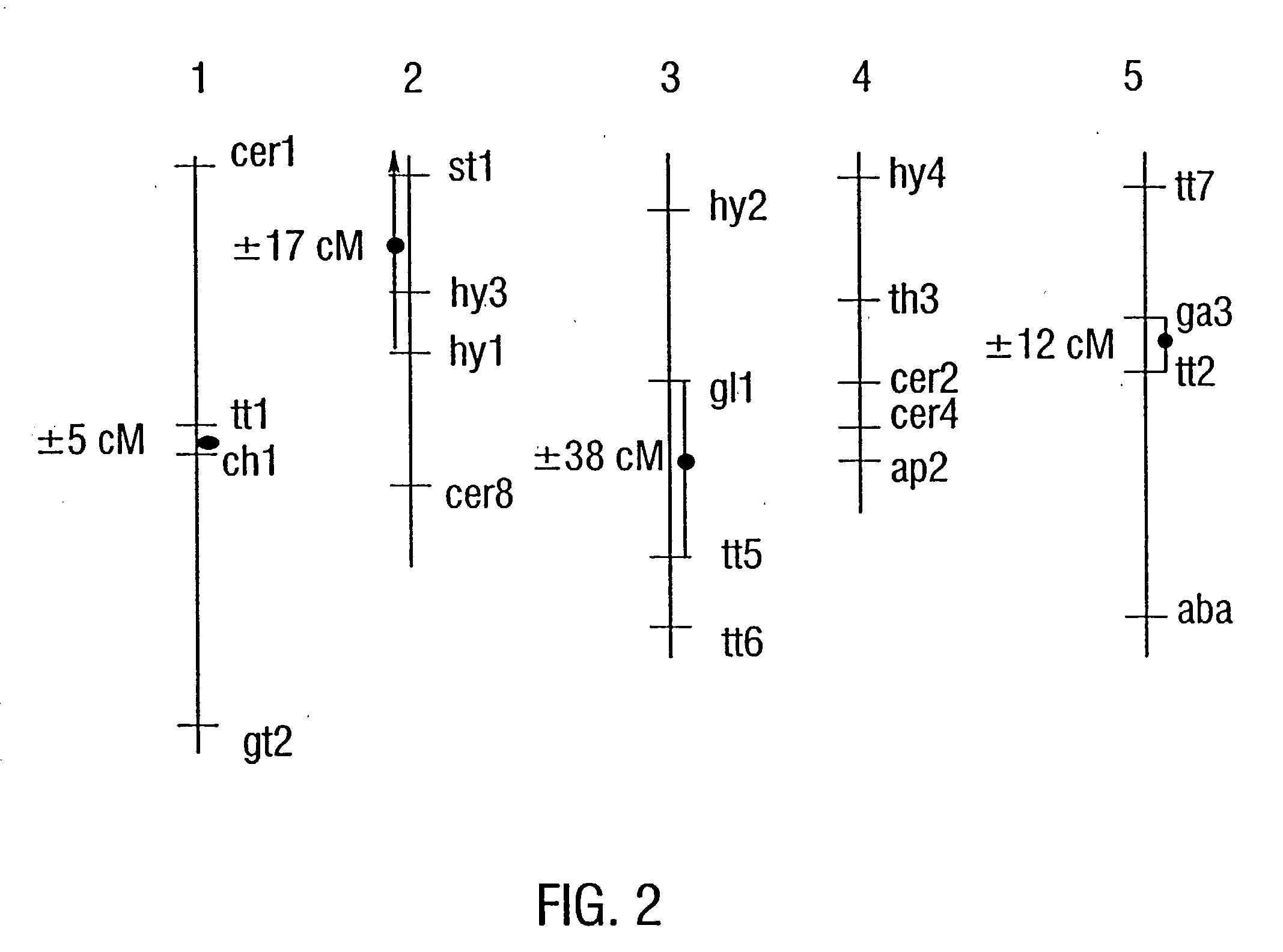Plant artificial chromosome compositions and methods
a technology of artificial chromosomes and chromosomes, applied in the field of molecular biology, can solve the problems of inability to precisely remove the integrated dna, the rearrangement of introduced dna sequences, and the inability to carry new genetic information, etc., and achieve the effect of conferring susceptibility
- Summary
- Abstract
- Description
- Claims
- Application Information
AI Technical Summary
Benefits of technology
Problems solved by technology
Method used
Image
Examples
example 1
Generation of an Arabidopsis thaliana Mapping Population
[0208] To generate a pollen donor plant, two alleles of qrtl were crossed to one another. The qrtl-1 allele was in the Landsberg ecotype background and the qrtl-2 allele was in the Columbia ecotype background. The Landsberg ecotype was readily discernible from the Columbia ecotype because it carries a recessive mutation, erecta, which causes the stems to thicken, infloresences to be more compact, and the leaves to be more rounded and small than wildtype. To utilize this as a marker of a donor plant, qrtl-2 pollen was crossed onto a qrtl-1 female stigma. The F1 progeny were heterozygous at all molecular markers yet the progeny retain the quartet phenotype of a tetrad of fused pollen grains. In addition, progeny display the ERECTA phenotype of the Columbia plant. This visible marker serves as an indication that the crossing was successful in generating plants segregating ecotype specific markers. Further testing was done to the ...
example 2
Tetrad Pollinations
[0210] Tetrad pollinations were carried out as follows. A mature flower was removed from the donor plant and tapped upon a glass microscope slide to release mature tetrad pollen grains. This slide was then placed under a 20-40× Zeiss dissecting microscope. To isolate individual tetrad pollen grains, a small wooden dowel was used to which an eyebrow hair with rubber cement was mounted. Using the light microscope, a tetrad pollen unit was chosen and touched to the eyebrow hair. The tetrad preferentially adhered to the eyebrow hair and was thus lifted from the microscope slide and transported the recipient plant stigmatic surface. The transfer was carried out without the use of the microscope, and the eyebrow hair with adhering tetrad was then placed against the recipient stigmatic surface and the hair was manually dragged across the stigma surface. The tetrad then preferentially adhered to the stigma of the recipient and the cross pollination was completed.
[0211] ...
example 3
Genetic Mapping of Centromeres
[0212] To map centromeres, F1 plants which were heterozygous for hundreds of polymorphic DNA markers were generated by crossing quartet mutants from the Landsberg and Columbia ecotypes (Chang et al. 1988; Ecker, 1994; Konieczy and Ausubel, 1993). In tetrads from these plants, genetic markers segregate in a 2:2 ratio (FIG. 6; Preuss et al. 1994). The segregation of markers was then determined in plants which were generated by crossing pollen grains from the F1 plants onto a Landsberg homozygote. The genotype of the pollen grains within a tetrad was inferred from the genotype of the progeny. Initially, seeds were generated from greater than 100 successful tetrad pollinations, and tissue and seeds were collected from 57 of these. This provided sufficient material for PCR, as well as seeds necessary for producing the large quantities of tissue required for Southern hybridization and RFLP mapping. In order to obtain a more precise localization of the centro...
PUM
| Property | Measurement | Unit |
|---|---|---|
| diameter | aaaaa | aaaaa |
| temperatures | aaaaa | aaaaa |
| temperatures | aaaaa | aaaaa |
Abstract
Description
Claims
Application Information
 Login to View More
Login to View More - R&D
- Intellectual Property
- Life Sciences
- Materials
- Tech Scout
- Unparalleled Data Quality
- Higher Quality Content
- 60% Fewer Hallucinations
Browse by: Latest US Patents, China's latest patents, Technical Efficacy Thesaurus, Application Domain, Technology Topic, Popular Technical Reports.
© 2025 PatSnap. All rights reserved.Legal|Privacy policy|Modern Slavery Act Transparency Statement|Sitemap|About US| Contact US: help@patsnap.com



